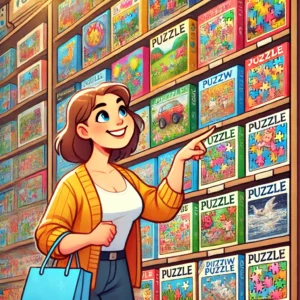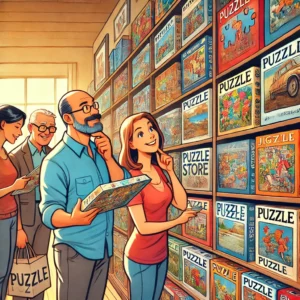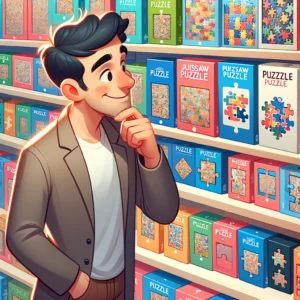A Jigsaw Puzzle Box can tell you if a puzzle is good. OR a bad jigsaw puzzle.

Standing in the puzzle aisle, surrounded by rows of colorful boxes, can feel like a dream for a jigsaw puzzle lover to check out the jigsaw puzzle boxes lined up. With so many choices, it’s easy to get swept up in eye-catching artwork and fun designs, but how do you know if the puzzle inside is the right one for you?
A Jigsaw Puzzle Box is Your First Look
Since a new puzzle is sealed, the jigsaw puzzle box is your only source of information. From piece count to image complexity, the details on the box can help you decide whether to take that puzzle home or leave it on the shelf. Deep in that puzzle box is a few
Table of Contents
Before you grab the first puzzle that catches your eye, here’s what you should look for on the box to make the best choice.
A few years ago, I walked into a local toy store and spotted a beautiful 1000-piece jigsaw puzzle featuring a stunning autumn landscape. The rich orange and red leaves practically glowed on the box, and I knew I had to have it. I glanced at the details. It was 1000 pieces, matte finish, high-quality thick pieces, and a poster included. Everything looked promising, so I took it home. When I started assembling it, I was thrilled!!! The image was crisp, the pieces locked together well, and the experience was exactly what I had hoped for.
That day, I learned an important lesson: the jigsaw puzzle box tells you everything you need to know before buying.

Choosing a jigsaw puzzle isn’t just about the image on the front. The jigsaw puzzle box contains key details that can make or break your puzzling experience. Before you bring a puzzle home, here’s what you should look for to ensure you’ll love every moment of putting it together.
The Jigsaw Puzzle Image: Do You Love It?
First things first: Do you actually like the jigsaw puzzle’s image?
- Is it colorful and engaging, or does it have large sections of solid color that might be difficult to solve?
- Do you prefer scenic landscapes, detailed artwork, collages, or abstract patterns?
- Does it spark immediate joy just looking at it?
You’re going to stare at this image for hours. It should be something that excites you. If the image doesn’t make you happy, the puzzle-solving process won’t either. Even if the quality is top-notch, a dull or frustrating image can make the puzzle feel like a chore instead of an enjoyable challenge.
Piece Count & Difficulty Level
The piece count is usually printed boldly on the front of the box, but there’s more to consider than just numbers.
- 500 pieces: Great for beginners or a quick challenge.
- 1000 pieces: The standard for puzzlers who want a solid, enjoyable challenge.
- 1500 pieces: For those who love a more time-consuming project.
- 3000 pieces: Be sure you have the space (and patience) to tackle it!
A 1000-piece puzzle with lots of repeating colors or patterns may be much harder than a 1500-piece puzzle with distinct sections and bright contrasts. Check the image carefully to make sure the difficulty level matches your skills and enjoyment level.
Puzzle Dimensions: Will It Fit Your Space?
Not all puzzles are the same size, even if they have the same number of pieces.
Some 1000-piece puzzles might be long and narrow, while others are square. The dimensions are often listed on the side or back of the box. This is especially important if you:
- Have a limited workspace (small table, coffee table, or puzzle board).
- Plan to frame the puzzle when completed and need a specific size.
- Like bigger puzzle pieces for easier handling.
Puzzle sizes vary by brand and cut style, so even two puzzles with the same piece count may take up drastically different amounts of space. If you plan to frame it, make sure the dimensions work with standard frame sizes to avoid extra hassle.
Piece Shape & Cutting Style
Different puzzle brands use different cutting styles – this affects how the pieces fit together and your overall solving experience.
Look for clues on the box about:
- Grid-cut vs. random-cut pieces. Grid-cut puzzles have uniform, structured shapes, while random-cut pieces vary in shape and can be trickier.
- False fits. Some brands have similar-looking pieces that fit in multiple places, which can make solving frustrating.
- Larger or smaller pieces. Some puzzles cater to people who prefer larger, easier-to-handle pieces.
A tight fit ensures that pieces won’t fall apart when bumped, while loose-cut pieces might shift easily. If the box doesn’t mention the cut style, a quick online search can provide insights from other puzzlers.
Puzzle Quality: Check for Clues
Not all puzzles are made the same. A high-quality puzzle is worth the investment, but how can you tell just from the box?
- Thicker cardboard or wood puzzles tend to be more durable.
- Matte vs. glossy finish – matte pieces reduce glare, while glossy ones may reflect light.
- Loose or tight fit – some puzzles stay together better, while others fall apart easily when moved.
- Dust inside the box – some brands have more puzzle dust, which can be annoying when sorting pieces.
A well-made puzzle feels satisfying to put together, while a flimsy, poorly cut puzzle can be frustrating. If the box mentions “precision cut” or “premium quality,” it’s usually a good sign.
Extra Features: Does It Offer Something Special?
Some puzzles come with fun extras that enhance the experience:
- A poster of the puzzle image (super helpful for reference).
- Unique-shaped pieces (also called whimsy pieces) for added variety.
- Glow-in-the-dark, textured, or double-sided designs.
- Mystery or escape-room themes that add an extra challenge.
If you enjoy puzzles with a little something extra, check the back of the box for these features. They can add an entirely new layer of enjoyment!
Price and Value

Puzzles come in a wide range of prices, so consider the quality vs. cost. You can tell by looking at a jigsaw puzzle box and figure out what type of value you have with the puzzle inside. I always ask these questions:
- Is this a budget-friendly puzzle for casual fun?
- Or is it a high-quality puzzle meant for framing or long-term use?
- Are there better deals for the same puzzle online?
Sometimes, a slightly more expensive puzzle is worth it if it means better quality, a more enjoyable experience, and a puzzle that will last longer. These secrets work even if the box is sealed as it’s quite easy to see how puzzle manufacturers consider how they present the jigsaw puzzles by looking at the box
Take Your Time to Choose Wisely!
A puzzle is more than just an image. It’s an experience and an emotional journey. You get to see every spec on every piece as you place the jigsaw puzzle pieces together. Taking a moment to inspect the box carefully can help you avoid frustration and ensure that you’ll love every minute of assembling your puzzle.
By keeping these details in mind and carefully looking at the jigsaw puzzle box, you can confidently pick the perfect puzzle to bring home.
